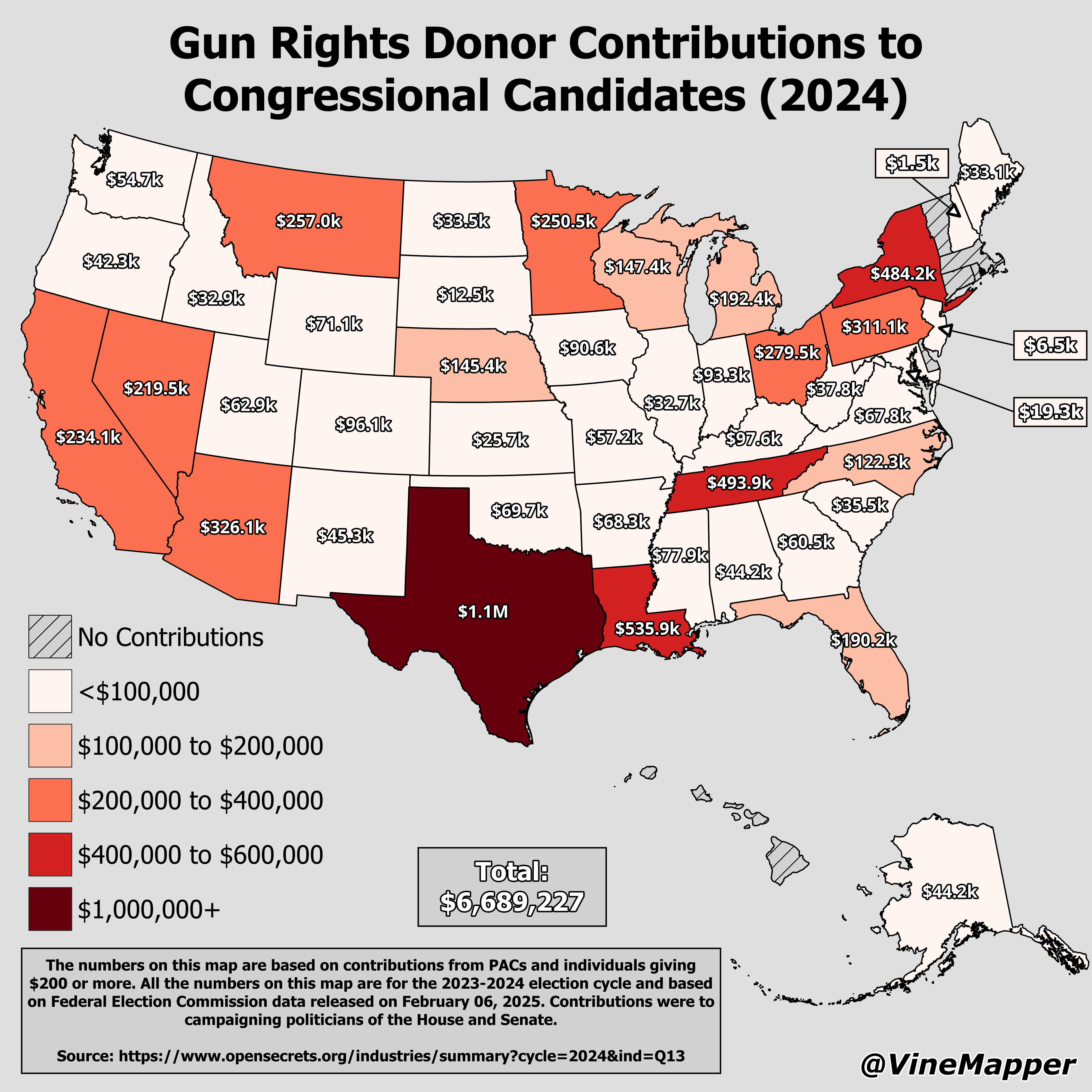Gun Rights Donor Contributions to Congressional Candidates Map


Marcus Rodriguez
Historical Geography Expert
Marcus Rodriguez specializes in historical cartography and geographic data analysis. With a background in both history and geography, he brings unique...
Geographic Analysis
What This Map Shows
The "Gun Rights Donor Contributions to Congressional Candidates (2024) Map" provides a detailed visualization of the financial contributions made by donors who advocate for gun rights to candidates running for Congress in the 2024 election cycle. This map highlights the geographical distribution of these donations, allowing viewers to see where support for gun rights is strongest and how it correlates with the political landscape across the United States. Understanding these contributions can shed light on the influence of gun rights advocacy groups and their impact on legislative agendas.
Deep Dive into Gun Rights Advocacy
Gun rights advocacy has been a polarizing topic in American politics, often reflecting broader cultural and regional differences. Organizations such as the National Rifle Association (NRA) and Gun Owners of America mobilize considerable financial resources to support candidates who align with their policy objectives. Interestingly, the financial contributions from these groups often vary significantly across different states and districts, influenced by local attitudes towards gun ownership and regulation.
In 2024, the stakes are particularly high as various states grapple with contentious gun laws. For instance, states like Texas and Florida, known for their strong gun culture, have historically received more substantial contributions from gun rights donors. In contrast, states with stricter gun control measures, such as California and New York, tend to see less financial support for candidates who advocate for gun rights. This geographical disparity is not just a reflection of local laws but also of the differing societal values regarding firearms.
What’s fascinating is how these contributions play a crucial role in shaping the political landscape. Candidates who receive substantial backing from gun rights donors may prioritize legislation that favors less regulation and more access to firearms. For example, in the 2020 election cycle, candidates who were backed by gun rights groups often campaigned on platforms that included measures to expand concealed carry laws and oppose universal background checks.
Furthermore, the map can also serve as a barometer for the increasing polarization surrounding gun rights. In recent years, we have seen a rise in grassroots movements advocating for stricter gun control, often in response to high-profile incidents of gun violence. This pushback can result in a counter-movement where gun rights donors ramp up their contributions to ensure that their voices are heard in Congress.
Regional Analysis
When analyzing the map, it’s essential to break down contributions by region. For instance, in the Southern United States, gun rights donors contribute significantly to candidates, reflecting the region's cultural affinity for firearms. States like Alabama and Mississippi show a high concentration of contributions, suggesting strong local support for pro-gun candidates. In contrast, the Northeast, particularly areas like Massachusetts and New Jersey, shows markedly lower contributions, aligning with the region's more stringent gun control laws.
Midwestern states exhibit a mixed picture. Illinois, with its urban centers advocating for stricter gun laws, contrasts sharply with rural areas where gun rights are more widely supported. Even within the same state, there can be stark differences in donor contributions, reflecting the varied views on gun ownership among urban and rural populations.
Interestingly, Western states present a unique case. States like Montana and Idaho often support gun rights candidates, yet larger metropolitan areas, such as Denver, may skew towards supporting candidates who favor stricter regulations. This duality illustrates how urbanization and demographic shifts can influence political contributions.
Significance and Impact
The implications of gun rights donor contributions extend beyond mere numbers; they impact legislation, electoral outcomes, and the broader societal discourse on gun ownership. As Congress approaches pivotal votes on gun control measures, understanding the financial backing that candidates receive is crucial for interpreting potential legislative changes.
Moreover, with gun violence remaining a pressing issue in the United States, the relationship between these contributions and public policy will likely continue to evolve. The 2024 election is expected to be a battleground for gun rights discussions, and how candidates respond to donor influences could set the tone for future legislation.
In conclusion, the "Gun Rights Donor Contributions to Congressional Candidates (2024) Map" is not just a representation of financial data; it is a reflection of the ongoing debate surrounding gun rights in America. By examining the geographical distribution of these contributions, we gain insight into how money influences politics and the ongoing struggle between differing ideologies regarding gun ownership and regulation. The path forward will be shaped by both public opinion and the financial might of advocacy groups, making this topic more relevant than ever.
Visualization Details
- Published
- September 20, 2025
- Views
- 68
Comments
Loading comments...